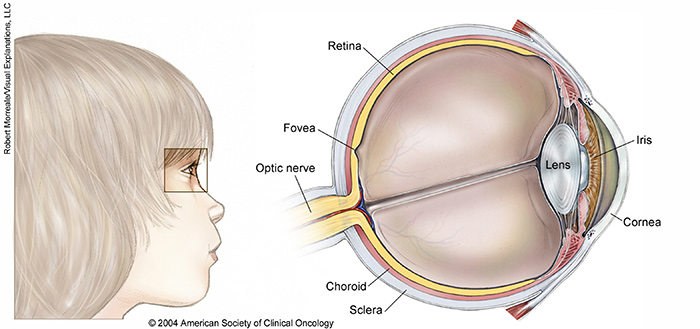ON THIS PAGE: You will find some basic information about retinoblastoma and the parts of the body it may affect. This is the first page of Cancer.Net’s Guide to Childhood Retinoblastoma. Use the menu to see other pages. Think of that menu as a roadmap for this entire guide.
Cancer begins when healthy cells change and grow out of control, forming a mass called a tumor. A tumor can be cancerous or benign. A cancerous tumor is malignant, meaning it can spread to other parts of the body. A benign tumor means the tumor can grow but will not spread.
Retinoblastoma is a rare cancer that begins in the part of the eye called the retina. The retina is a thin layer of nerve tissue that coats the back of the eye and enables the eye to see. Most often, retinoblastoma is unilateral, meaning it occurs only in 1 eye. However, it may be present in both eyes, called bilateral. If retinoblastoma spreads, it can spread to the lymph nodes, bones, or the bone marrow, which is the soft, spongy-like material found inside large bones. Rarely, it may involve the central nervous system (CNS; brain and spinal cord).
Children may be born with retinoblastoma, but the disease is rarely diagnosed at birth. Most children diagnosed with retinoblastoma can be cured, even if the retinoblastoma has spread beyond the eye. An important goal of treatment in children with retinoblastoma is preserving vision.

Looking for More of an Introduction?
If you would like more of an introduction, explore these related items. Please note that these links will take you to other sections on Cancer.Net:
-
Find a Cancer Doctor. Search for a cancer specialist in your local area using this free database of doctors from the American Society of Clinical Oncology (ASCO).
-
Cancer Terms. Learn what medical phrases and terms used in cancer care and treatment mean.
The next section in this guide is Statistics. It helps explain the number of children who are diagnosed with retinoblastoma and general survival rates. Use the menu to choose a different section to read in this guide.
